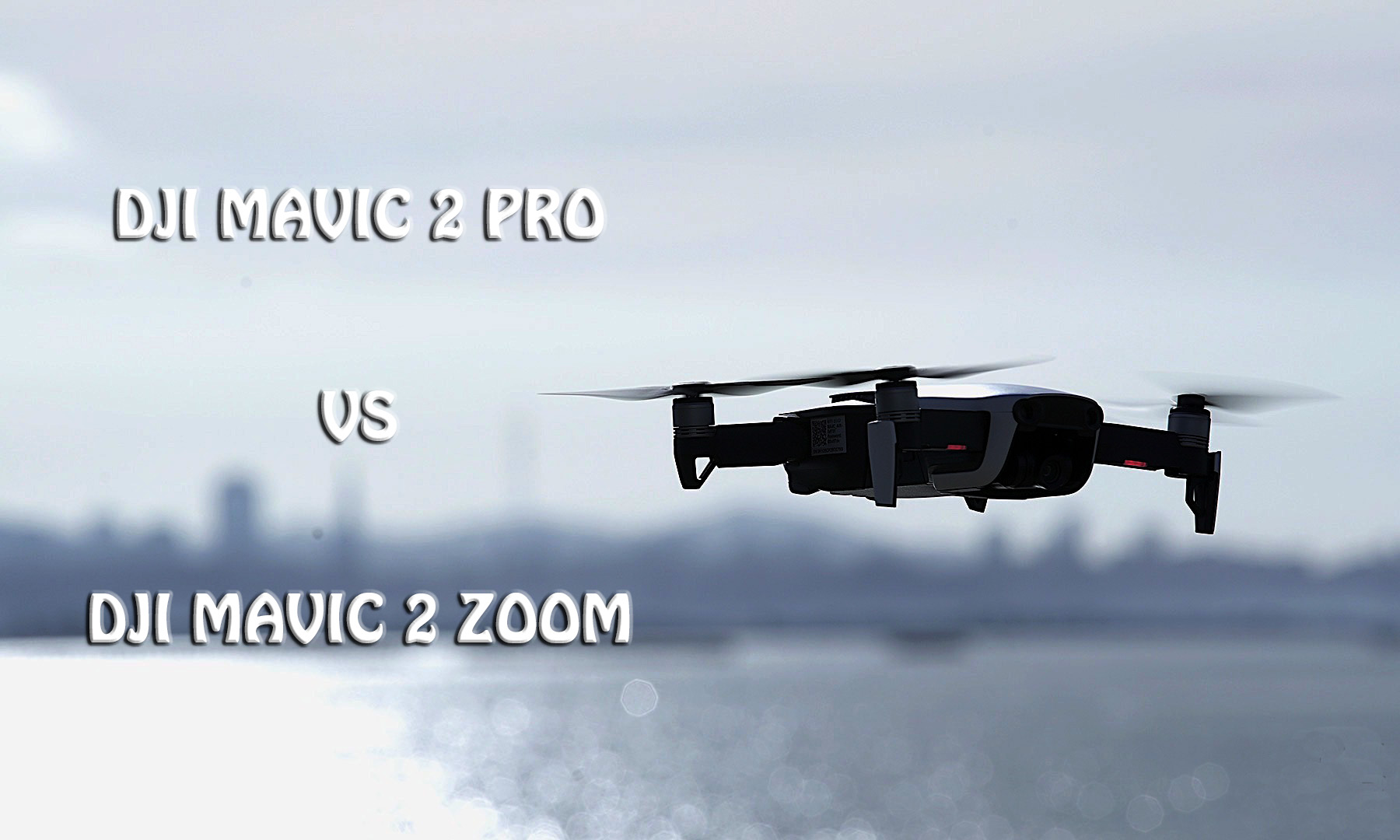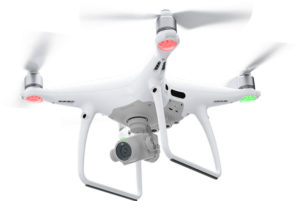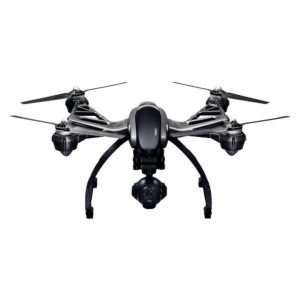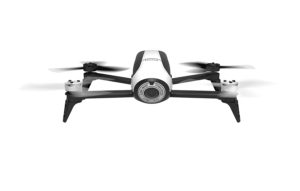DJI Mavic 2 Pro and DJI Mavic 2 Zoom, without any doubt, are the two hottest releases of this year. DJI, the beloved drone brand has been manufacturing state-of-the-art drones over the years and established itself as one of the leading drone manufacturers in the industry. This year, they have finally released the much talked about Mavic 2.
Most of the drone enthusiasts are misled with the fact that DJI Mavic 2 Pro and Zoom are two different models. But the truth is, DJI has released two different versions of the same model – Mavic 2. This is the first time they have done that.
DJI Mavic 2 Pro VS. DJI Mavic 2 Zoom General Comparison
[table id=69 /]
After a faintly subdued leak and DJI Mavic Pro 2 rumors stated in several websites and a postponed launch in July, the manufacturers have finally announced the release of its two Mavic 2 sequels. The DJI Mavic 2 Zoom and DJI Mavic 2 Pro are the newest foldable drones; giving the drone enthusiasts a harder decision to make if they didn’t already bought the Mavic Air.
Both the drones seem to have their own pros and cons but they are pretty much the same except for the camera features. Thus, it is critically important that you read and research the features of both the drones before making any buying decision.
The Mavic 2 quadcopters are designed keeping in mind the growing needs of drone photographers and filmographers. Yes, the manufacturers have placed extra focus on the camera features this time on their two variations of Mavic 2.
The differences between DJI Mavic 2 Zoom and DJI Mavic 2 Pro come down to the 4K cameras. Do you want color-rich video, crisper or tightly zoomed shots? Well, it is going to be hard and you may have to make some tough decisions.
Read our DJI Mavic Pro 2 vs. Zoom comparison review to get the precise examples of all the features and differences.
DJI Mavic Pro 2 vs. Zoom – Design
The Mavic 2 quadcopters, through their foldable arms, keep the iconic design made famous by the original Mavic Pro. However, the shape and design of the Mavic 2 drones have been slightly improved when compared to the original Mavic, with more ergonomic and smoother edges.
Both DJI Mavic 2 Pro and Zoom have the same color scheme and folding mechanism as before. However, their improved, slightly more aerodynamic appearance seemingly reduces body drag by 19% and let them reach the faster maximum speed of 44 mph when operated in Sport Mode.
DJI, from the beginning, have emphasized on their drones’ obstacle avoidance systems and both Mavic 2 quadcopters improve this feature further. Yes, the DJI Mavic 2 Pro and Zoom includes ten sensors on all sides. This makes the automated flight mode features like ‘follow me’ even more robust and handy.
Further, the Mavic 2 quadcopters are apparently quieter as they boast a quieter propulsion system with noise-reducing propellers. This is good news for all the drone enthusiasts who have previously joked and tagged DJI drones ‘flying lawnmowers.’
Lastly, the super-bright LED light placements on the back arms of the Mavic 2 drones make them operate when flying far away. p
DJI Mavic Pro 2 vs. Zoom – Camera
This is where the comparison begins. Both DJI Mavic 2 Pro and Zoom may be based on the same design and shoot 4K at 100Mbps, but there is a huge difference between their sensors and cameras.
DJI Mavic Pro 2 Specs (only Mavic 2 Pro specific)
[asa2]B07GXVMZ45[/asa2]
Camera Design
TheDJI Mavic 2 Pro drone boasts a unique camera. The camera is quite large due to the fact that they have integrated a large image sensor. However, the camera is still small enough to be easily installed inside the drone. To accomplish this, the manufacturers designed the camera square on the outside with a small spherical lens on the inside. But the CP and ND filters are absent in Mavic 2 Pro and you will have to pay extra if you want one.
The camera on Mavic 2 Pro may seem large on their site photos but in reality, it is quite smaller than the DJI Phantom 4’s camera. The square design of the camera allows it to fit in the tiny space on the drone. This makes the camera look relatively small and sleek in design.
- Hasselblad Natural Color Solution (HNCS) and 10-bit Dlog-M Color Profile
When it comes to colors, the DJI Mavic 2 Pro quadcopter uses HNCS technology for more accurate and natural colors. Moreover, this version supports a 10-bit Dlog-M Color Profile that generates deeper and dynamic range colors for both still images and videos. With this upgraded color profile that Mavic 2 Pro boast; it has the ability to record over 1 billion colors, which is several times more than the Zoom variant that apparently records 16 million colors. If you haven’t heard of log color profile before, it is nothing but a way of retrieving a more dynamic range of colors from images without requiring to shoot RAW uncompressed videos.
- HDR Video
The Mavic 2 Pro, with 4K 10-bit HDR support, can be plugged into a 4K HLG TV. You can playback all the footage including pictures with the right color tones, increased contrast, and brighter highlights that make the HDR feature so appealing. The best part, everything can be achieved without spending time on post-editing.
- Hasselblad Camera with 1-inch Image Sensor
With the acquisition of Hasselblad, a Swedish camera company, DJI has moved a step ahead. Hasselblad is known for manufacturing expensive medium range cameras for photographers and are even used by NASA for their expeditions. With that said, DJI has incorporated Hasselblad’s technology into its Mavic 2 Pro. So if image quality is your priority, this drone will not disappoint you. The true 20MP 1-inch Hasselblad image sensor creates super sharp images. However, there is no Super Res functionality; the 20MP camera will not disappoint you during your filmography ventures. Meanwhile, the pixels are physical; you can actually snap shots with movements in them. On the other hand, 1-inch camera sensor gives DJI Mavic 2 Pro an increased megapixel count, giving the drone enhanced low light capabilities.
- Adjustable Aperture
One of the best DJI Mavic Pro 2 specs that no one is talking about is the inclusion of an adjustable aperture. The Mavic 2 Pro’s lens has an aperture that can go from f2.8 to f11. This functionality gives an opportunity to the photographers to take part in flexible long-exposure photography and other scenarios where more precise exposure control is required. Moreover, for close up shooting, the f2.8 aperture combined with a larger sensor allows you to snap pictures with a DSLR-like look.
- 4K Lossless Crop
The DJI Mavic 2 Pro doesn’t come with an optical zoom lens. Instead, it has a 20MP sensor that allows you to shoot 4K videos in crop mode giving you around 1.4X lossless zoom. Technically speaking, the resolution of the 4K recording mode and 1.4X crop are exactly the same. In fact, 1.4X is slightly better as it produces better video quality. This means that you don’t have to scale the pictures up and down to adjust the right resolution. The high-quality 4K crop mode feature in Mavic 2 Pro makes everything look great.
DJI Mavic 2 Zoom Specs (only Mavic 2 Zoom specific)
[asa2]B07GD9XY6J[/asa2]
Camera Design
As compared to the camera design of DJI Mavic 2 Pro, the Mavic 2 Zoom has a small, durable, and symmetrical camera design. Due to its round shape, it is easy to find circularly polarized (CP) and neutral density (ND) lens filters, something that was not seen in Mavic 2 Pro. Mavic 2 Zoom’s neutral density filters come in four sets – ND4, ND8, ND16, and ND32. The ND filters are protected by a sturdy silicone case and there are markings to describe each filter space. This makes it easier for the user to use the filter he/she wants without taking out each filter. These high-end filters are easy to remove and install. You just have to remove the UV filter from the drone and screw your required filter in its place.
You may have to pay $20-$30 bucks extra if you want CP and ND filters for your Mavic 2 Pro.
- Unique Zoom Lens
The Mavic 2 Zoom boasts a unique zoom lens that keeps the 1/2.3 image sensor size. But what really is striking is the zoom lens that keeps the 2X focal length. The 24mm-48mm zoom is really impressive as you will be amazed to experience the number of dynamic perspectives it provides. This means that you will get perfect compositions from even a farther distance and for creating a more dramatic look, you can even change the field of view. The new zoom lens will definitely trigger your creativity as you can enjoy 4X lossless zoom when capturing full HD videos.
- Super Res
Apart from having the super powerful zoom lens, what makes Mavic 2 Zoom stand out is its new photography feature called Super Res. The 48MP super-resolution photos are achievable with Super Res feature. When you take a picture in 24mm field of view, Mavic 2 Zoom’s camera using its telephoto lens will capture and patch nine photos and form a 48MP super-resolution photo showing intense details. It works in a way that the Super Res shooting mode captures multiple images using zoom lens and chains them together to form an image that 4X the resolution of an actual image. This is an exceptionally helpful photography feature required for landscape photography. However, there is one flaw. The Super Res feature is only applicable when used for capturing still images. The zoom doesn’t allow to capture objects with movements. This doesn’t mean that drone also should not be moving. The drone can move but the object you are capturing should be super still.
- Super Incredible Dolly Zoom
This fantastic DJI Quickshot mode is the first time a drone is equipped with. Also known as the Vertigo effect, the Dolly Zoom feature works when the Mavic 2 Zoom flies backward. That is, it creates an animated effect in which the object remains that same but the background becomes narrower or wider. The lens will zoom in slowly when the drone is flying backward for creating a unique perspective shift. In real-world photography, this effect is something that takes a lot of settings and practice to perfect it. But with Mavic 2 Zoom, you can accomplish it with a single press of a button. This video effect is achievable in other camera drones as well but it takes a lot of practice and experience to perfect it. On the other hand, it requires good software for editing. DJI, by introducing the Dolly Zoom feature has managed to understand one of the most influential modes of photography that incorporates the relationship between the background and the foreground and compression. The background grows bigger while the foreground (main subject) remains the same while creating a 3D parallax effect. This feature can benefit filmmakers who are always trying different shots with their camera.
- Continuous Autofocus
This is another feature that is absent in DJI Mavic 2 Pro. The Mavic 2 Zoom incorporates contrast detection and phase detection continuous feature. However, the autofocus functionality in Mavic 2 Zoom is not easy to understand or operate. It requires experience as it fails to continuously keep the main subject in focus. But there are ways to achieve it. You can set the aperture to the maximum that makes everything in the frame focused. Or you can slide the focus control when your drone is taking a flight in order to put everything in focus.
These are the main camera differences of DJI Mavic 2 Pro and DJI Mavic 2 Zoom quadcopters. Now let’s talk about what both the drones have to offer equally.
Photo Features of Mavic 2 Drones
1 HyperLight
The HyperLight camera feature is used for advanced photography during the night. It snaps a string of photos and combines them together for creating the best results. The HyperLight camera feature is especially used for reducing noise during nighttime photography. It takes a lot of editing to remove those grainy artifacts from the photos captured in dim light. But the HyperLight camera functionality of both Mavic 2 Pro and Mavic 2 Zoom provides a simple way capturing nightlife photos without requiring expensive editors. The HyperLight photos drastically reduce noise by providing a low setting.
2 D-HDR
The D-HDR is another feature used in both the Mavic 2 models. The D-HDR mode takes a series of RAW photographs and combines them into different stops of dynamic range – 13 stops on Mavic 2 Zoom and 14 stops on Mavic 2 Pro. This functionality also helps reduce items like motion blur, red eye, and more that shows up when capturing old-style exposure bracketed shots.
Video Features of Mavic 2 Drones
1 H.265
DJI has introduced the HEVC feature, also known as H.265 video compression format that allows you to maintain the same video quality even when its size is reduced to half.
2 Higher Bitrate
Shooting in 4K requires higher bitrate; else, it will affect the video resolution.DJI Mavic 2 Pro and DJI Mavic 2 Zoom cameras have higher bitrate that ensures the recorded 4K video is compressed before it is stored in the MicroSD card. Higher bitrate means the video will be less compressed thereby maintaining the integrity and quality of the video. Both the Mavic 2 drones record at 100Mbps that is faster than most of the camera drones.
DJI Mavic Pro 2 vs. Zoom – Build Quality and Durability
When it comes to build quality and durability, both the Mavic 2 drones are built like a brick outhouse. Like the original Mavic Pro drone, the Mavic 2 drones are the sturdiest and well-built drones. The latest versions are slightly on the heavier side due to the incorporated upgrades. The users who have operated both the drones are confident that DJI Mavic 2 Pro and Zoom could bounce around in your backpack, bump into branches and barrel into bushes and live to fly another day.
DJI Mavic Pro 2 vs. Zoom – Battery Time and Recharge Time
As per the manufacturers, the Mavic 2 drones have the maximum flight time of 29 minutes when operated in optimal conditions and friendly environment. On the other hand, their aerodynamic design allows them to stay airborne for about 31 minutes, given that they are accelerating at a constant speed of 7mph.
However, during a flight test, we conducted on both the Mavic 2 drones, we let the drones hover for a certain period until the battery drained out they landed themselves automatically. Our flight test lasted an average of 27 minutes and 15 seconds that’s pretty close the claimed 29 minutes from DJI.
Further, during our hover flight tests (15 in total), we logged different flight times and averaged them out.
Our DJI Mavic 2 Pro averaged a flight time of 29 minutes and 12 seconds – that’s somewhat close to DJI’s claimed 31 minutes.
On the other hand, our DJI Mavic 2 Zoom averaged a flight time of 28 minutes 33 seconds, which is not as long as promised flight time by DJI.
However, with these flight tests, we are able to conclude that the Mavic 2 drones are no slouch in the battery department.
But it took us 55-60 minutes to completely charge the batteries that is nowhere close to the claimed 45 minutes. Still, the numbers are far more impressive as compared to its previous models.
DJI Mavic Pro 2 vs. Zoom – Autonomy, Control, and Piloting
The Mavic 2 drones feel exactly the same as the original Mavic Pro when operated. This means, both DJI Mavic 2 Pro and Zoom are supremely responsive, athletic, and tight when airborne. Even if you are a beginner or a first-time flyer, you will feel right at home when operating the Mavic 2 quadcopters.
However, DJI Mavic 2 Pro may feel slightly more difficult to fly and operate as compared to Zoom, especially when it comes to camera features.
The camera operations are a bit confusing in DJI Mavic 2 Pro. Apart from this, both the drones are extremely compatible for the users, both advanced fliers and beginners. There are no slippery controls, wandering, or drifting. The Mavic 2 drones are meant for the sky.
The sturdy omni-directional obstacle avoidance system gives the user more confidence and vigor while flying the drones. If you are about to crash these Mavic 2 drones, DJI’s software will alert you with a beep sound as you approach any obstacles. If you tend to overlook the alert and keep flying the drones, they will auto-brake to avoid the collision.
However, it was found out that the auto-brake system in DJI Mavic 2 Zoom was not very responsive. On the other hand, the right and left sensors are only activated when you turn on the ActiveTrack mode while the drone is flying itself.
But even with the left and right sensors disabled, these drones feel extremely reliable and safe.
DJI Mavic 2 Zoom and DJI Mavic Pro 2 Release Date and Price
Both the DJI Mavic 2 Pro and Zoom are available to pre-order today according to the manufacturers. The DJI Mavic 2 Zoom is the cheaper model that cost around $1200 that’s closer to the price of the original Mavic Pro quadcopter.
On the other hand, the DJI Mavic 2 Pro is the most expensive of the Mavic 2 drones priced around $1500.
Which Mavic 2 is Right for You?
Both the DJI Mavic 2 Zoom and DJI Mavic 2 Pro have their benefits and flaws. But what we think is the Mavic 2 drones are not meant for everybody. As their functionalities are more inclined towards aerial photography and filmography, these drones are best suitable for filmmaking and rescue operations. Both the drones are exactly the same in terms of built and design but what makes this huge price difference is the different camera functionalities. So you can avail any according to your needs.



